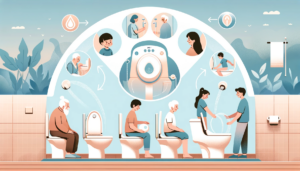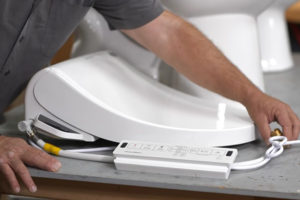Unraveling the History of Bidets: A Journey Through Time and Hygiene
The bidet, a French word meaning “small horse,” has a fascinating history dating back to the 17th century. Originally a simple basin used for washing, it has evolved into a sophisticated bathroom fixture that offers enhanced personal hygiene. Its journey through history reflects changing attitudes towards cleanliness and technology.
- Origins in France: The bidet originated in France in the early 17th century. This French word, meaning ‘pony’, was aptly named, as users would straddle the bidet as if riding a small horse. Its initial purpose was for the aristocracy to maintain high standards of personal hygiene, especially after various activities.
- Early Designs: The earliest bidets were essentially basins positioned in bedrooms, not bathrooms. They were filled with water by hand and used without plumbing. This rudimentary form was a symbol of high social standing and personal cleanliness.
- Adoption Across Europe: By the 18th century, bidets had spread across Europe, becoming a standard fixture in the homes of the wealthy. They were considered essential for intimate cleansing and as a part of the daily hygiene routine.
- Technological Innovations in the 19th Century: The 19th century saw significant changes in bidet design with the advent of indoor plumbing. Bidets started to be installed in bathrooms, and their use became more practical and widespread.
- The Impact of World War II: After World War II, American soldiers, stationed in Europe, encountered bidets and brought back stories of these curious European fixtures. This exposure, although initially met with skepticism, slowly started influencing perceptions in North America.
- Evolution into Modern Bidets: Modern bidets, including bidet toilet seats, emerged in the 20th century with features like adjustable water temperature and pressure, making them more comfortable and effective. This transition marked a significant leap from the basic bidet to an advanced personal hygiene tool.
- Popularity in Asia and the Middle East: In many parts of Asia and the Middle East, the bidet became a common bathroom fixture, valued for its hygienic benefits. Countries like Japan further advanced bidet technology, integrating electronic controls and features like heated seats and warm air dryers.
From Aristocratic Indulgence to Global Phenomenon
Initially a luxury for European aristocracy, the bidet symbolized a higher standard of personal care. Post World War II, advancements in plumbing and a growing emphasis on hygiene helped transform it from a symbol of luxury to a standard bathroom fixture, particularly in parts of Europe and Asia.
- Changing Social Norms: As the bidet became more widespread, it transitioned from a luxury item for the aristocracy to a common household item. This shift was influenced by changing social norms around personal hygiene and the increasing importance of cleanliness in public health.
- Bidets in Public Consciousness: The introduction of bidet seats and the integration into existing toilets made bidets more accessible. They began to appear not only in homes but also in hotels and public restrooms, marking their evolution into a standard bathroom fixture.
- Environmental Considerations: The environmental impact of toilet paper production led to a reevaluation of bidets. With their ability to reduce toilet paper usage, bidets emerged as an eco-friendly alternative, aligning with growing environmental consciousness.
- Medical and Health Benefits: The bidet gained recognition for its health benefits, especially for individuals with medical conditions like hemorrhoids or those with sensitive skin. The gentle water cleanse is seen as a more soothing and hygienic alternative to toilet paper.
- Cultural Resistance and Acceptance: Despite its practicality, the bidet faced cultural resistance in some regions, particularly in North America. However, over time, increased awareness about hygiene and the environmental benefits has led to a gradual acceptance.
- The Role of Technology and Innovation: Technological advancements have played a crucial role in the bidet’s evolution. Features like adjustable temperature settings, self-cleaning nozzles, and air dryers have enhanced the user experience, pushing the bidet from a niche product to a mainstream hygiene solution.
- Globalization of the Bidet: Today, the bidet is not just a European or Asian phenomenon but is gaining popularity worldwide. It’s seen as an essential part of modern bathroom design, reflecting a global shift towards improved hygiene and comfort.
Beyond Toilet Paper
The modern bidet offers a hygienic alternative to toilet paper. Utilizing adjustable water pressure and temperature settings, it provides a more thorough cleaning. This shift towards water-based cleaning is seen as not only more effective but also more environmentally friendly.
Shift to Water-Based Cleaning: The transition from using just toilet paper to integrating bidets marked a significant change in personal hygiene. Water cleans more effectively, reducing the risk of irritation and infections, especially for sensitive skin.
- Environmental Impact: The bidet significantly reduces the reliance on toilet paper, which is crucial for environmental conservation. This reduction in paper usage helps in saving trees and reducing waste in septic systems.
- Inclusivity in Hygiene: Bidets offer an inclusive solution for those with mobility issues or certain health conditions. The easy-to-use features of modern bidets make personal hygiene accessible to everyone.
- Public Health and Hygiene: The increased use of bidets has implications for public health. By improving personal hygiene, bidets contribute to overall community health, especially in preventing the spread of pathogens.
- Personal Comfort and Convenience: The comfort provided by bidets, with features like warm water and adjustable water pressure, enhances the bathroom experience, making it more pleasant and luxurious.
- Economic Benefits: Over time, investing in a bidet can be economically beneficial. The reduced need for toilet paper can lead to significant cost savings for households.
- Hygiene Education: The rise in bidet use has spurred more discussions and education about personal hygiene practices, leading to a more informed and health-conscious society.
A Squeaky Clean History
Over time, the design of bidets has evolved significantly. From standalone basins to bidet toilet seats that can be attached to an existing toilet, these fixtures now often include features like heated seats, warm air dryers, and adjustable temperature settings. This evolution reflects a continuous effort to improve comfort and efficiency in personal hygiene.
- Integration with Existing Toilets: The development of bidet seats that can be attached to existing toilets revolutionized the industry, making bidets more accessible and easier to install in standard bathrooms.
- Technological Advancements: Modern bidets incorporate advanced technology like remote controls, self-cleaning nozzles, and programmable user settings, offering a highly personalized hygiene experience.
- Heated Seats and Warm Air Dryers: The addition of heated seats and warm air dryers in bidets has added a level of comfort previously unattainable, especially in colder climates.
- Adjustable Features: Modern bidets come with adjustable features such as water temperature and pressure control, allowing users to customize their experience for maximum comfort and effectiveness.
- Eco-Friendly Materials: The use of sustainable and eco-friendly materials in bidet manufacturing reflects a commitment to environmental stewardship.
- Design Aesthetics: The evolution of bidet design has not only focused on functionality but also on aesthetics, with sleek, modern designs that complement contemporary bathroom decor.
- Global Standardization: The standardization of bidet features and design across different manufacturers has made it easier for users to operate bidets, regardless of the brand or model.
Bidets Around the World
The bidet’s popularity varies globally. This cultural variation highlights different attitudes towards personal hygiene and the adoption of new technologies.
- Bidets in Europe: In many European countries, bidets have been a long-standing fixture in bathrooms, reflecting a cultural emphasis on thorough personal hygiene practices.
- The Japanese Bidet Revolution: Japan has been at the forefront of bidet technology, with features like integrated toilet bidets becoming a standard in households and public spaces.
- Adoption in the Middle East: In Middle Eastern cultures, water is traditionally used for cleansing after using the toilet, making bidets a culturally compatible and widely accepted hygiene solution.
- Slow Acceptance in North America: Despite initial resistance, North America is gradually embracing bidets, particularly in the wake of environmental concerns and awareness about personal hygiene.
- Bidets in the Hospitality Industry: Globally, many luxury hotels and resorts have adopted bidets as a standard feature, providing guests with a more comprehensive and hygienic bathroom experience.
- Educational Efforts and Campaigns: Various global campaigns and educational efforts are promoting the benefits of bidets, helping to overcome cultural barriers and misconceptions.
- Diverse Designs for Different Regions: The bidet industry has adapted to regional preferences and requirements, offering a range of designs and features tailored to different cultural and practical needs.
The history of bidets is not just about a bathroom fixture; it’s about the evolution of personal hygiene practices over centuries. From its aristocratic origins to becoming a modern tool for cleanliness, the bidet’s story is intertwined with our own history of hygiene. In Australia, as in many parts of the world, the bidet is gaining recognition for its practical and environmental benefits. We invite you to explore this fascinating piece of history and consider how it might enhance your own daily routine.


 Shift to Water-Based Cleaning: The transition from using just toilet paper to integrating bidets marked a significant change in personal hygiene. Water cleans more effectively, reducing the risk of irritation and infections, especially for sensitive skin.
Shift to Water-Based Cleaning: The transition from using just toilet paper to integrating bidets marked a significant change in personal hygiene. Water cleans more effectively, reducing the risk of irritation and infections, especially for sensitive skin.

